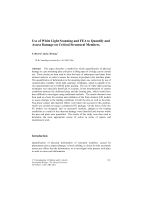Bridges

- Publication no: ABC-AAI013-11
- Published: 31 October 2011
- PDF (free) Download
This paper describes a method by which quantification of physical damage to a pin mounting plate critical to a lifting span of a bridge can be carried out. These results are then used to form the basis of subsequent non-linear finite element analysis in order to assess the stresses at pin/plate joint interface plane. The quantification of deformation to the mounting plate was carried out by use of commercially available ‘white light scanning’ techniques, which is capable of insitu measurements up to 0.08mm point spacing. The use of white light scanning techniques was especially beneficial in accurate, in-situ determination of contact conditions between the deformed plate and the bearing pins, which would have been difficult to investigate using traditional methods. The results obtained were then used as a basis for creation and validation of the finite element (FE) models to assess changes to the loading conditions in both the pins as well as the plate. Non-linear contact and material effects were taken into account in this analysis, which was carried out using a commercial FE package. On the basis of the two FE models (‘as designed’ and ‘as measured’ models), changes to the loading conditions as a result of the observed damage were identified and stresses within the pins and plate were quantified. The results of this study were then used to determine the most appropriate course of action in terms of repairs and maintenance work.
